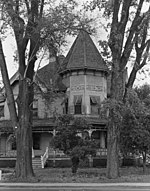Selland Arena

Selland Arena is a multi-purpose arena built in 1966 that makes up part of a four-venue complex of the Fresno Convention and Entertainment Center in Fresno, California. It is named after former Fresno mayor Arthur L. Selland and has had over 10 million people walk through its doors in its over 50-year history. The arena originally had a 6,582 seating capacity, but a US$10 million expansion project in 1981 increased the seating to its current capacity of 10,132. Before the 1997-1998 Fresno State basketball season, capacity was increased to 10,220. The Selland Arena underwent an additional $15 million renovation in November 2006, that included the installation of new seats, a new video replay scoreboard, message boards and a new ice-cooling system for hockey games.Currently, the arena is operated by ASM Global under contract from the City of Fresno.
Excerpt from the Wikipedia article Selland Arena (License: CC BY-SA 3.0, Authors, Images).Selland Arena
M Street, Fresno
Geographical coordinates (GPS) Address External links Nearby Places Show on map
Geographical coordinates (GPS)
| Latitude | Longitude |
|---|---|
| N 36.733093 ° | E -119.78271 ° |
Address
Selland Arena
M Street 700
93721 Fresno
California, United States
Open on Google Maps









